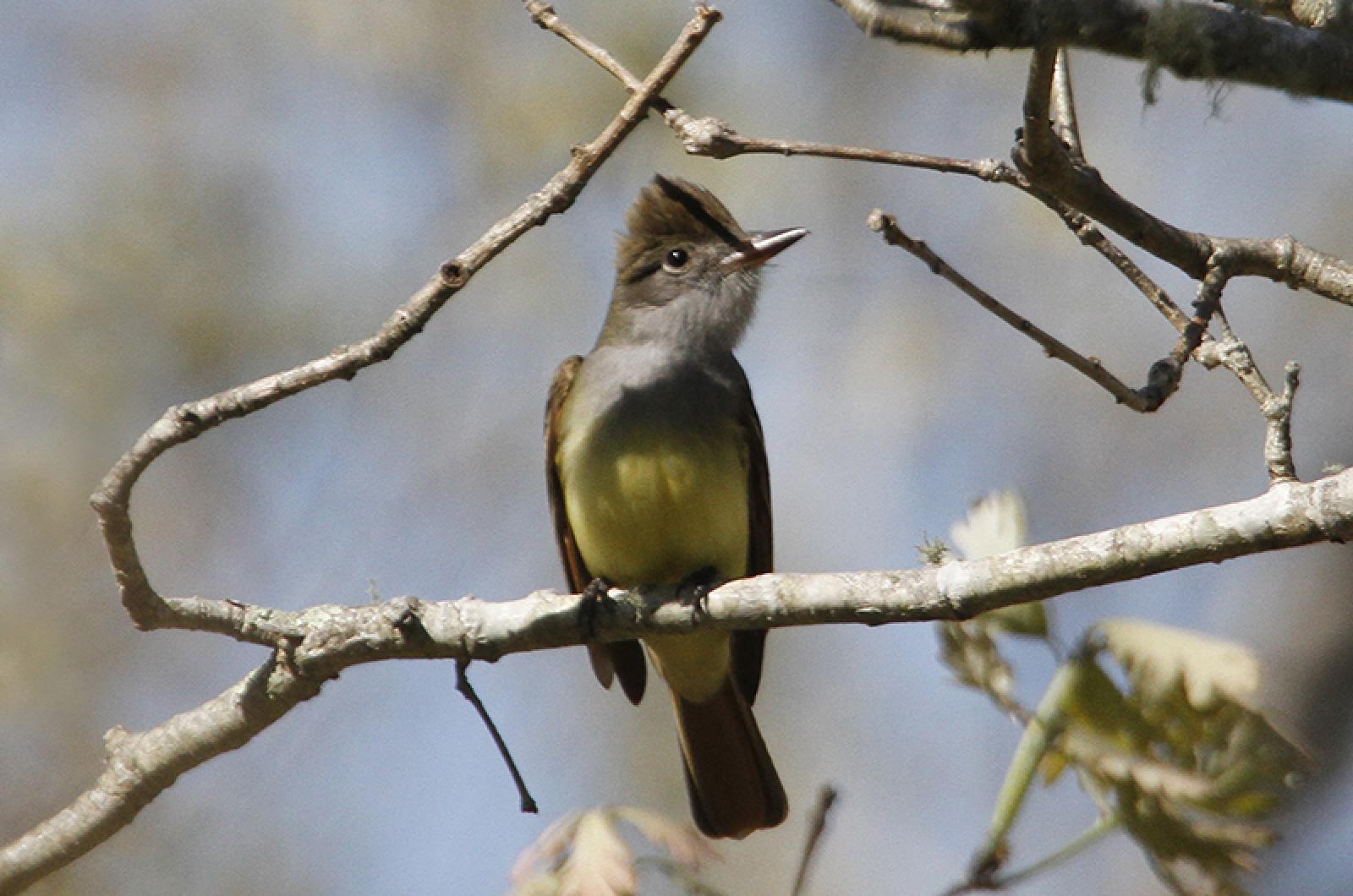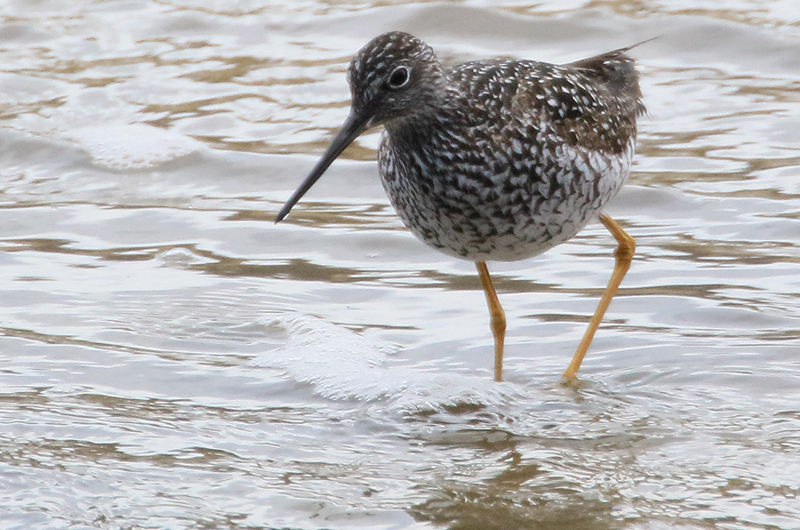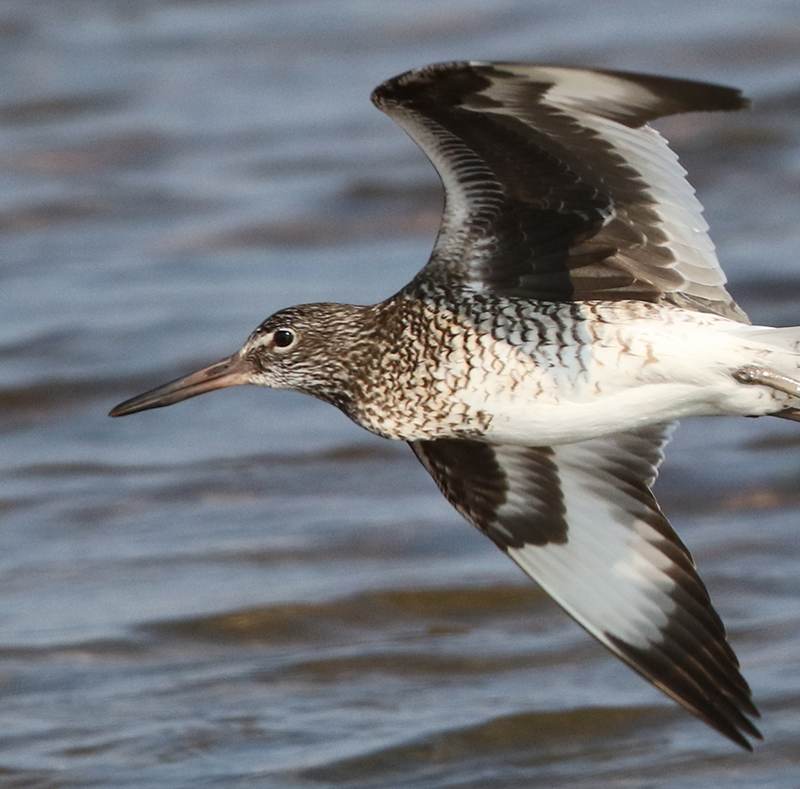A male painted bunting, one of the more colorful birds you will see, was spotted by Maureen Williams in her yard on May 18. He gorged on sunflower seed for two hours until it got dark. This blue, green, red and brown bird (you read that right) is a southern overshoot which does not nest north of South Carolina, Oklahoma, and Arkansas. This is the second sighting in May, as a female painted bunting showed up on May 6 at a feeder in West Tisbury.
Another unexpected sighting is an eastern meadowlark found by Cheska Zayda in a meadow along the Road to Great Neck in West Tisbury on May 15. Fifty years ago this species was still a fairly common breeding species, but it probably has not nested on the Vineyard in at least twenty years.
The third exciting sighting is the addition of a new nesting species to the Vineyard’s avifauna! Common ravens are nesting about halfway up the tower by the Verizon building. On May 8 I observed a young raven that was near fledging. Tony Lima reports that the youngster has fledged as of May 16. Hope Sisson Tripp lives next door and a raven visits her yard daily to eat the chicken eggs and treats she puts out for them. She adds that they nested there last year too, and that one of the young ravens was a regular visitor in her yard.
On May 19 I walked a new-to-me trail at the Caroline Tuthill Preserve. The trail runs near the edge of some shrub swamps near the Edgartown water company’s Lily Pond well field. I was with Mike Tinus and we watched chickadees and nuthatches when a ruby-crowned kinglet popped into view right over our heads.
Morgan Hodgson reports that the whip-poor-wills have returned to the Lobsterville area as he heard them calling on May 18. Allen Keith reports that a chuck-will’s-widow is calling near Mermaid Farm on Middle Road.
John Nelson went to Cape Poge on May 18 where ruddy turnstones were abundant all the way to the gut. He also counted 18 oystercatchers, 16 willets, 14 piping plovers and bank swallows at the Cape Poge lighthouse. There were seven black skimmers and a large colony of least terns on Norton Point, and at the Farm Institute he found a female bobolink.
Bird Sightings
Allan Keith spotted a “western” palm warbler at Great Rock Bight on May 15, a race of the palm warbler that has less yellow on the undersides. We are more likely to see this race in the fall as they are unprecedented in the spring. On May 16 he and Susan Whiting visited
Squibnocket where they found an early willow flycatcher.
Gus Ben David had a female pine siskin hanging around his feeders on May 15 and 16. He is also inundated with Baltimore orioles. He reports so many of them that he can not keep his jelly feeders stocked! His red-breasted nuthatches have departed for their more northern breeding grounds.
The Felix Neck Bird-a-Thon was held on May 10 and 11. We were fortunate that the weather cooperated, so while it rained Friday night, the daylight hours of Friday and Saturday were both good days for observing birds. We found 134 species on Martha’s Vineyard, which is a really good total.
We found 17 species of warblers, and eight of them are migrants that do not nest here. In most years we only find our resident breeding warblers during the bird-a-thons. Other highlights of our efforts were summarized in last week’s column.
Here is a list of all the species we found: brant, Canada goose, mute swan, wood duck, American black duck, mallard, harlequin duck, common eider, surf scoter, white-winged scoter, black scoter, red-breasted merganser, wild turkey, common loon, Cory’s shearwater, northern gannet, double-crested cormorant, great cormorant, great blue heron, great egret, snowy egret, green heron, black-crowned night-heron, turkey vulture, osprey, northern harrier, Cooper’s hawk, red-tailed hawk, black-bellied plover, American golden plover, semipalmated plover, piping plover, killdeer, American oystercatcher, spotted sandpiper, greater yellowlegs, eastern willet, ruddy turnstone, sanderling, dunlin, least sandpiper, semipalmated sandpiper, white-rumped sandpiper, short-billed dowitcher, American woodcock, Wilson’s snipe, Bonaparte’s gull, ring-billed gull, herring gull, lesser black-backed gull, great black-backed gull, least tern, roseate tern, common tern, black skimmer, rock pigeon, mourning dove, barn owl, eastern whip-poor-will, chimney swift, Virginia rail, sandhill crane, ruby-throated hummingbird, belted kingfisher, red-headed woodpecker, red-bellied woodpecker, downy woodpecker, hairy woodpecker, northern flicker, eastern wood-pewee, eastern phoebe, great crested flycatcher, eastern kingbird, yellow-throated vireo, blue-headed vireo, red-eyed vireo, blue jay, American crow, fish crow, common raven, horned lark, tree swallow, northern rough-winged swallow, bank swallow, barn swallow, black-capped chickadee, tufted titmouse, red-breasted nuthatch, white-breasted nuthatch, Carolina wren, house wren, golden-crowned kinglet, ruby-crowned kinglet, eastern bluebird, wood thrush, American robin, gray catbird, northern mockingbird, European starling, cedar waxwing, blue-winged warbler, northern parula, yellow warbler, chestnut-sided warbler, black-throated blue warbler, yellow-rumped warbler, black-throated green warbler, yellow-throated warbler, pine warbler, prairie warbler, bay-breasted warbler, black-and-white warbler, American redstart, prothonotary warbler, ovenbird, common yellowthroat, hooded warbler, eastern towhee, chipping sparrow, field sparrow, Savannah sparrow, song sparrow, white-throated sparrow, white-crowned sparrow, scarlet tanager, northern cardinal, rose-breasted grosbeak, red-winged blackbird, common grackle, brown-headed cowbird, Baltimore oriole, house finch, American goldfinch and house sparrow.
The northward migration of birds is peaking and the torrent of migrants will continue through the month of May. Please report your sightings to birds@mvgazette.com.
Robert Culbert schedules private guided birding tours, and is an ecological consultant with Nature Watch LLC living in Vineyard Haven.








Comments
Comment policy »